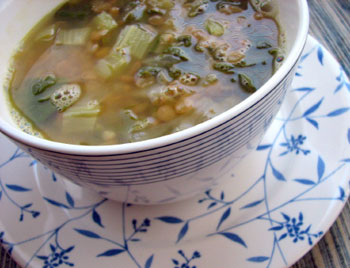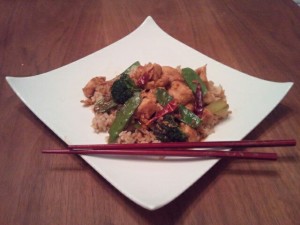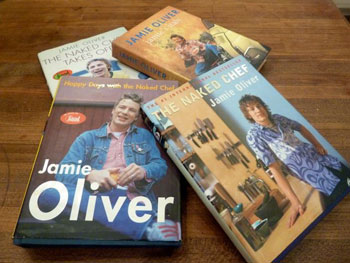 |
Spicy Pumpkin Seeds – Great with beer Classic Margarita – Blending is not allowed. Lila’s Guacamole – The best way to eat green. Huevos alla Amy – A breakfast treat. Tortilla Soup - In case it's still cold in your neck of the woods. Topopo Salad – A salad of volcanic proportions. Ceviche – Cool and refreshing. Enchiladas Suizas – Simply delicious. Mexican Chicken – Spicing it up. Goat Cheese and Poblano Quesadillas with Pineapple-Habanero Salsa - For those who like it HOT! Grilled Steak Tacos with Watermelon-Mango-Jicama Salsa - It's not a celebration without tacos & salsa. |
Global Cuisine
Global Cuisine
Syrian Lentil Chard Soup
 When I was growing up, "leafy green vegetable" meant spinach. At some point swiss chard was added to the repertoire and then bok choy. But that was really it. Oh sure, we had salad every night, but no other cooked leafy greens. Later on I discovered the sharp bite of mustard greens, the silky mellowness of cooked escarole and the spicy bitterness of turnip greens. These days my organic market delivery brings me kale and collard greens too. But I still like spinach and swiss chard for sentimental reasons.
When I was growing up, "leafy green vegetable" meant spinach. At some point swiss chard was added to the repertoire and then bok choy. But that was really it. Oh sure, we had salad every night, but no other cooked leafy greens. Later on I discovered the sharp bite of mustard greens, the silky mellowness of cooked escarole and the spicy bitterness of turnip greens. These days my organic market delivery brings me kale and collard greens too. But I still like spinach and swiss chard for sentimental reasons.
Another category mainly skipped over in my childhood was legumes. We ate Mexican refried beans, chili beans, and baked beans, but that was about it. I guess if I had been raised in the South I might have been exposed to more beans and greens, but I wasn't. In college on a budget I lived on black beans, and in Italy I discovered white or cannellini beans. Out on my own I experimented with lentil stews and soups of all kinds until I discovered a recipe for Syrian lentil and chard soup. That was it. No other lentil recipes need apply.
K-Hole Kung Pao Chicken
 The biggest lesson I learned when stepping up from someone who occasionally cooked for herself to someone who cooks for a living is that the quality of ingredients is at the apex of importance. Actually, I think tasting the difference between food cooked with cheap or old elements, and fresh, high quality ingredients is a skill everyone develops whether they cook or not. This past summer I was walking home from the gym and passed a Mr. Softee truck. I was feeling depleted and entitled from my workout and stopped for a van/choc swirl cone- a prized acquisition in my childhood.
The biggest lesson I learned when stepping up from someone who occasionally cooked for herself to someone who cooks for a living is that the quality of ingredients is at the apex of importance. Actually, I think tasting the difference between food cooked with cheap or old elements, and fresh, high quality ingredients is a skill everyone develops whether they cook or not. This past summer I was walking home from the gym and passed a Mr. Softee truck. I was feeling depleted and entitled from my workout and stopped for a van/choc swirl cone- a prized acquisition in my childhood.
And you know something? It was disgusting. It tasted exactly like cold, wet plastic. And I was shocked- because I had decided that it was the most delicious and incredibly naughty reward I could give myself. I finished it of course but I had this sneaking suspicion that I would have felt happier had I rewarded myself with something that was good for me like one of the peaches from a local fruit stand. There are things that we all loved as a child that our adult palates won’t tolerate.
And that brings me to Chinese food. As I have mentioned before, I grew up in New York City, on a hearty diet of Chinese take-out at least once or twice a week. It’s what you did. And it was fantastic, I swear. But these days… I cannot figure out why I can’t recapture the blissful Chinese delivery food orgy of my childhood. It all tastes like crap to me, like used fry oil and old ingredients and people skimming every last cent of quality into their bank accounts.
Matt Armendariz' Sopaipillas
 There are just some things that instantly take me back to my childhood. Sopaipillas do that to me every time. Made by my grandmother, the tender warm pillows of fried dough were sprinkled with cinnamon sugar and drizzled with honey and always disappeared within minutes. She would encourage us to eat them immediately while they were still warm, but it was always said with a wink in her eye – she knew we couldn’t keep our hands off them until there was an empty plate of grease-laden cinnamon-scented crumbs.
There are just some things that instantly take me back to my childhood. Sopaipillas do that to me every time. Made by my grandmother, the tender warm pillows of fried dough were sprinkled with cinnamon sugar and drizzled with honey and always disappeared within minutes. She would encourage us to eat them immediately while they were still warm, but it was always said with a wink in her eye – she knew we couldn’t keep our hands off them until there was an empty plate of grease-laden cinnamon-scented crumbs.
My grandmother was the best cook I have ever known (next to my mom, of course!). She was in the kitchen every day and her way with food was astonishing, no matter what she prepared. But unlike her rice and beans, sopaipillas were for special events (as were her bunuelos, too). It was usually Christmas or New Year’s Eve when she would make dough and fry it in her cast iron skillet, and I always wondered why we had to wait so long. To a child eleven months might as well be an eternity.
Traveling the world you’re bound to find various versions of hot-oil-meets-dough desserts, whether it be beignets, youtiao, malasadas, loukoumades or gulab jamun. Unfortunately I adore every single one of them. But sopaipillas top my list, and not just because of their familial significance but also because they are among the most basic of all fried dough desserts. A very simple dough puffs up in the hot oil in a matter of minutes, and when drizzled with honey it’s pure nirvana.
Quick & Easy Steak with Mushrooms and Bok Choy
 If you have as many chef crushes as I do, here’s some good news: you don’t have to break up with your favorite chefs in order to lose weight, you just have to redefine your relationships…
If you have as many chef crushes as I do, here’s some good news: you don’t have to break up with your favorite chefs in order to lose weight, you just have to redefine your relationships…
And here’s a Jamie Oliver “recipe re-do” to prove the point: Skinny Steak with Mushrooms, Bok Choy and Gingered Tamari Sauce.
From the moment Jamie burst on the scene–with dishes that were both simple and sophisticated, and a style of cooking that was casual and fun–I was a fan; never questioning his recipes, I just cooked. But now, 30+ pounds lighter and with an eye on the health of everyone in my family, I do question the ingredients and instructions for every recipe I make and, though I still adore Jamie and his dishes, I happily alter them.
Found in Happy Days with the Naked Chef, the original version of this quick and easy recipe calls for one 8-ounce sirloin steak per person. Without getting into the other health risks of eating too much red meat, it’s just an awful lot of fat and calories…32 grams of fat, to be exact, and roughly 500 calories–about a third of the calories I need in an entire day… And I’m not talking about the fat and calories in the whole meal, just the portion of the plate that’s protein!
By reducing that super-sized portion of beef and using meat-mimicking magic mushrooms to fill out the plate you can still enjoy the taste and sensation of a beef dinner but with half the fat, cholesterol and calories.
More Articles ...
Welcome to the new One for the Table ...
Our Home Page will be different each time you arrive.
We're sure you'll find something to pique your interest...


